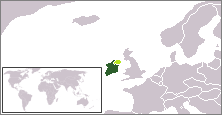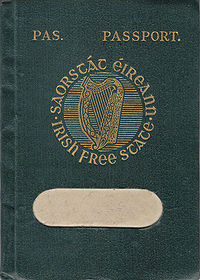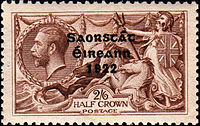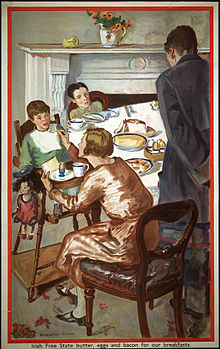
Irish Free State
About this schools Wikipedia selection
The articles in this Schools selection have been arranged by curriculum topic thanks to SOS Children volunteers. Do you want to know about sponsoring? See www.sponsorachild.org.uk
| Irish Free State Saorstát Éireann |
||||||
| Dominion within the British Empire from 1922 to 1931, Dominion within the British Commonwealth from 1931 to 1937 | ||||||
|
||||||
|
||||||
| Anthem The Soldier's Song |
||||||
|
Territory of the Irish Free State in 1922.
Dark green: Irish Free State. Light green: Territory claimed by the Irish Free State. |
||||||
| Capital | Dublin | |||||
| Languages | Irish English |
|||||
| Government | Parliamentary democracy under constitutional monarchy |
|||||
| Monarch | ||||||
| - | 1922–1936 | George V | ||||
| - | 1936 | Edward VIII | ||||
| - | 1936–1937 | George VI | ||||
| Governor-General | ||||||
| - | 1922–1927 | Timothy Michael Healy | ||||
| - | 1928–1932 | James McNeill | ||||
| - | 1932–1936 | Domhnall Ua Buachalla | ||||
| President of the Executive Council | ||||||
| - | 1922–1932 | W. T. Cosgrave | ||||
| - | 1932–1937 | Éamon de Valera | ||||
| Legislature | Oireachtas | |||||
| - | Upper house | Seanad Éireann | ||||
| - | Lower house | Dáil Éireann | ||||
| History | ||||||
| - | Anglo-Irish Treaty | 6 December 1921 | ||||
| - | Constitution of the Irish Free State | 6 December 1922 | ||||
| - | Constitution of Ireland | 29 December 1937 | ||||
| Currency | Saorstát pound | |||||
The Irish Free State ( Irish: Saorstát Éireann Irish pronunciation: [sˠiːɾˠsˠˈt̪ˠaːt̪ˠ eːɾʲən̪ˠ]; 6 December 1922 – 29 December 1937) was the state established in 1922 as a Dominion of the British Empire under the Anglo-Irish Treaty signed by British and Irish representatives exactly twelve months beforehand. On the day the Irish Free State was established, it comprised the entire island of Ireland, but as expected Northern Ireland almost immediately exercised its right under the treaty to remove itself from the new state. The Irish Free State effectively replaced both the self-proclaimed Irish Republic (founded 21 January 1919) and the Provisional Government of Southern Ireland. W. T. Cosgrave, the first President of the Irish Free State had led both of these "governments" since August 1922.
The Irish Free State came to an end in 1937, when the citizens voted by referendum to replace the 1922 constitution. It was succeeded by the sovereign and current state of Ireland, which until 1949 was often referred to as Eire.
Historical background
The Easter Rising of 1916, and in particular the decision of the Anglo-Irish Field Marshal Lord French to execute many of its leaders after courts-martial, generated sympathy for the republican cause in Ireland. Meanwhile there was increasing opposition to the ongoing war in Europe and the Middle East. Republicans and some independent Nationalists led opposition to the idea of compulsory military service for Irish men in the conscription crisis of early 1918. The Conscription Crisis brought an end to the Irish Convention before it could find a solution to the Irish Question. The Irish Parliamentary Party, who supported the Allied cause in World War I in response to the passing of the Third Home Rule Bill in 1914 was discredited by the crisis. Many people had begun to doubt whether the Bill, passed by Westminster in 1914 but suspended for the duration of World War I, would ever come into effect. Meanwhile Irish republicans were further emboldened by successful revolutions in the Russian Empire, the German Empire, and the Austro-Hungarian Empire. In the December 1918 General Election, a large majority of Irish seats in the Westminster parliament of the United Kingdom of Great Britain and Ireland were won by Sinn Féin, with 73 of 105 constituencies returning Sinn Féin members. Sinn Féin was a previously non-violent separatist party founded by Arthur Griffith in 1905. Under Éamon de Valera's leadership from 1917, it had campaigned aggressively for an Irish republic.
On 21 January 1919, Sinn Féin MPs (who became known as Teachta Dála, TDs) refusing to sit in the British House of Commons at Westminster, assembled in Dublin and formed a single chamber Irish parliament called Dáil Éireann (Assembly of Ireland). It affirmed the creation of an Irish Republic and passed a Declaration of Independence, calling itself Saorstát Éireann in Irish. Although it was accepted by the overwhelming majority of Irish people, only Soviet Russia recognised the Irish Republic internationally.
The War of Independence was fought between the army of the Irish Republic, the Irish Republican Army (known now as the "Old IRA" to distinguish it from later organisations of that name), and the British Army, the Black and Tans, the Royal Irish Constabulary, the Auxiliary Division, the Dublin Metropolitan Police, the Ulster Special Constabulary and the Ulster Volunteer Force. On 9 July 1921, a truce was declared. On October 11 negotiations were opened under British Prime Minister David Lloyd George and Arthur Griffith, who headed the Irish Republic's delegation. The Irish Treaty delegation set up Headquarters in Hans Place, Knightsbridge and on 5 December 1921 at 11:15 am it was decided by the delegation during private discussions at 22 Hans Place to recommend the Treaty to the Dáil Éireann; negotiations continued until 2:30 am on 6 December 1921 after which the Treaty was signed by the parties.
That these negotiations would produce a form of Irish government short of the independence wished for by republicans was not in doubt. The United Kingdom could not offer a republican form of government without losing prestige and risking demands for something similar throughout the Empire. Furthermore, as one of the negotiators, Michael Collins, later admitted (and he was in a position to know, given his role in the independence war), the IRA at the time of the truce was weeks, if not days, from collapse, with a chronic shortage of ammunition. "Frankly, we thought they were mad", Collins said of the sudden British offer of a truce, although it was likely they would have continued in one form or another, given the level of public support. The President of the Republic, Éamon de Valera, realising that a republic was not on offer, decided not to be a part of the treaty delegation and so be tainted by more militant republicans as a "sellout". Yet his own proposals published in January 1922 fell far short of an autonomous all-Ireland republic.
As expected, the Anglo-Irish Treaty explicitly ruled out a republic. What it offered was dominion status, as a state of the British Empire, equal to Canada, Newfoundland, Australia, New Zealand and South Africa. Though less than expected by the Sinn Féin leadership, it was substantially more than the initial form of home rule within the United Kingdom sought by Charles Stewart Parnell from 1880, and a serious advancement on the Home Rule Act of 1914 that the Irish nationalist leader John Redmond had achieved through parliamentary proceedings. However, it all but confirmed the partition of Ireland between Northern Ireland and the Irish Free State. It was ratified by the Second Dáil, splitting Sinn Féin in the process.
Northern Ireland "opts out"
For about two days from 6 December 1922 Northern Ireland became part of the newly created Irish Free State. This constitutional episode arose because of the Anglo-Irish Treaty and the legislation introduced to give that Treaty legal effect.
The Treaty was given legal effect in the United Kingdom through the Irish Free State Constitution Act 1922. That Act established, on 6 December 1922, the new Dominion for the whole island of Ireland. Legally therefore, on 6 December 1922, Northern Ireland became an autonomous region of the newly created Irish Free State. However, the Treaty and the laws which implemented it also allowed Northern Ireland to opt out of the Irish Free State. Under Article 12 of the Treaty, Northern Ireland could exercise its opt out by presenting an address to the King requesting not to be part of the Irish Free State. Once the Treaty was ratified, the Houses of Parliament of Northern Ireland had one month (dubbed the Ulster month) to exercise this opt out during which month the Irish Free State Government could not legislate for Northern Ireland, holding the Free State’s effective jurisdiction in abeyance for a month.
Realistically, it was always certain that Northern Ireland would opt out of the Free State. The Prime Minister of Northern Ireland, Sir James Craig, speaking in the Parliament in October 1922 said that “when the 6th of December is passed the month begins in which we will have to make the choice either to vote out or remain within the Free State.”. He said it was important that that choice was made as soon as possible after 6 December 1922 “in order that it may not go forth to the world that we had the slightest hesitation”. On 7 December 1922 (the day after the establishment of the Irish Free State) the Parliament demonstrated its lack of hesitation by resolving to make the following address to the King so as to opt out of the Irish Free State:
”MOST GRACIOUS SOVEREIGN, We, your Majesty's most dutiful and loyal subjects, the Senators and Commons of Northern Ireland in Parliament assembled, having learnt of the passing of the Irish Free State Constitution Act, 1922, being the Act of Parliament for the ratification of the Articles of Agreement for a Treaty between Great Britain and Ireland, do, by this humble Address, pray your Majesty that the powers of the Parliament and Government of the Irish Free State shall no longer extend to Northern Ireland.”
Discussion in the Parliament of the address was short. Prime Minister Craig left for London with the memorial embodying the address on the night boat that evening, 7 December 1922. The King received it the following day, The Times reporting:
"YORK COTTAGE, SANDRINGHAM, DEC. 8. The Earl of Cromer ( Lord Chamberlain) was received in audience by The King this evening and presented an Address from the Houses of Parliament of Northern Ireland, to which His Majesty was graciously pleased to make reply."
With this, Northern Ireland had left the Irish Free State. If the Houses of Parliament of Northern Ireland had not made such a declaration, under Article 14 of the Treaty Northern Ireland, its Parliament and government would have continued in being but the Oireachtas would have had jurisdiction to legislate for Northern Ireland in matters not delegated to Northern Ireland under the Government of Ireland Act. This, of course, never came to pass.
On 13 December 1922 Prime Minister Craig addressed the Parliament informing them that the King had responded to the Parliament’s address as follows:
“I have received the Address presented to me by both Houses of the Parliament of Northern Ireland in pursuance of Article 12 of the Articles of Agreement set forth in the Schedule to the Irish Free State (Agreement) Act, 1922, and of Section 5 of the Irish Free State Constitution Act, 1922, and I have caused my Ministers and the Irish Free State Government to be so informed.”
Governmental and constitutional structures
The Treaty established that the new Irish Free State would be a constitutional monarchy, with a Governor-General. The Constitution of the Irish Free State made more detailed provision for the state's system of government, with a three-tier parliament, called the Oireachtas, made up of the King and two houses, Dáil Éireann and Seanad Éireann (the Irish Senate). Executive authority was vested in the King, and exercised by a cabinet called the Executive Council, presided over by a prime minister called the President of the Executive Council.
The Representative of the Crown
The King in Ireland was represented by a Governor-General of the Irish Free State. The office replaced the previous Lord Lieutenant, who had headed English and British administrations in Ireland since the Middle Ages. Governors-General were appointed by the King initially on the advice of the British Government, but with the consent of the Irish Government. From 1927 the Irish Government alone had the power to advise the King whom to appoint.
Oath of Allegiance
As with all dominions, provision was made for an Oath of Allegiance. Within dominions, such oaths were taken by parliamentarians personally towards the monarch. The Irish Oath of Allegiance was fundamentally different. It had two elements; the first, an oath to the Free State, as by law established, the second part a promise of fidelity, to His Majesty, King George V, his heirs and successors. That second fidelity element, however, was qualified in two ways. It was to the King in Ireland, not specifically to the King of the United Kingdom. Secondly, it was to the King explicitly in his role as part of the Treaty settlement, not in terms of pre-1922 British rule. The Oath itself came from a combination of three sources, and was largely the work of Michael Collins in the Treaty negotiations. It came in part from a draft oath suggested prior to the negotiations by President de Valera. Other sections were taken by Collins directly from the Oath of the Irish Republican Brotherhood, of which he was the secret head. In its structure, it was also partially based on the form and structure used in the Dominion of Canada.
Although controversially moderate by other dominion standards, and notably indirect in its reference to the monarchy (and hence widely criticised by unionists and other dominions), it was criticised by nationalists and republicans for making any reference to the Crown, the claim being that it was a direct oath to the Crown, a fact demonstrably incorrect by an examination of its wording. But in 1922 Ireland and beyond, it was the perception, not the reality, that influenced public debate on the issue. Had its original author, Michael Collins, survived, he might have been able to clarify its actual meaning, but with his assassination in 1922, no major negotiator to the Oath's creation on the Irish side was still alive, available or pro-Treaty. (The leader of the Irish delegation, Arthur Griffith, had also died in August 1922). The Oath became a key issue in the resulting Irish Civil War that divided the pro- and anti-treaty sides in 1922–23.
The Irish Civil War
The compromises contained in the agreement caused the civil war in the 26 counties in June 1922–April 1923, in which the pro-Treaty Provisional Government defeated the anti-Treaty Republican forces. The latter were led, nominally, by Éamon de Valera, who had resigned as President of the Republic on the treaty's ratification. His resignation outraged some of his own supporters, notably Seán T. O'Kelly. On resigning, he then sought re-election but was defeated two days later on a vote of 60-58. The pro-Treaty Arthur Griffith followed as President of the Irish Republic. Michael Collins was chosen at a meeting of the members elected to sit in the House of Commons of Southern Ireland (a body set up under the Government of Ireland Act 1920) to become Chairman of the Provisional Government of Southern Ireland in accordance with the Treaty. The general election in June gave overwhelming support for the pro-Treaty parties. W. T. Cosgrave's Crown-appointed Provisional Government of Southern Ireland effectively subsumed Griffith's republican administration with the death of both Collins and Griffith in August 1922.
The "freedom to achieve freedom"
Governance
The following were the principal parties of government of the Irish Free State between 1922 and 1937:
- Cumann na nGaedheal under W. T. Cosgrave (1922–32)
- Fianna Fáil under Éamon de Valera (1932–37)
Constitutional evolution
Michael Collins described the Treaty as 'the freedom to achieve freedom'. In practice, the Treaty offered most of the symbols and powers of independence. These included a functioning, if disputed, parliamentary democracy with its own executive, judiciary and written constitution which could be changed by the Oireachtas. However, a number of conditions existed:
- The King remained king in Ireland;
- Prior to the passage of the Statute of Westminster, the U.K. government continued to have a significant role in Irish governance. Officially the representative of the King, the Governor-General also received instructions from the British Government on his use of the Royal Assent, namely a Bill passed by the Dáil and Seanad could be Granted Assent (signed into law), Withheld (not signed, pending later approval) or Denied (vetoed). Letters patent to the first Governor-General Tim Healy had named explicitly Bills that if passed were to be blocked, such as any attempt to abolish the Oath. In the event, no such Bills were ever introduced, so the issue was moot.
- As a British Dominion, The Irish Free State, had limited autonomy. Entitlement of citizenship of the Irish Free State was defined in the Irish Free State Constitution, but the status of that citizenship was contentious. One of the first projects of the Irish Free State was the design and production of the Great Seal of Sáorstát Éireann which was carried out on behalf of the Government by Hugh Kennedy.
- The meaning of 'Dominion status' changed radically during the 1920s, starting with the Chanak crisis in 1922 and quickly followed by the directly negotiated Halibut Treaty of 1923. A reform of the King's title following an Imperial Conference decision and given effect by the Royal and Parliamentary Titles Act 1927, changed the King's royal title so that it took account of the fact that there was no longer a United Kingdom of Great Britain and Ireland. The King adopted the following style by which he would be known in all of his Empire: By the Grace of God, of Great Britain, Ireland and the British Dominions beyond the Seas King, Defender of the Faith, Emperor of India. That was the King's title in Ireland just as elsewhere in his Empire.
- In the conduct of external relations, The Irish Free State tried to push the boundaries of its status as a Dominion. It 'accepted' credentials from international ambassadors to Ireland, something no other dominion up to then had done. It registered the treaty with the League of Nations as an international document, over the objections of the United Kingdom, which saw it as a mere internal document between a dominion and the United Kingdom.
The Statute of Westminster (of 1931), embodying a decision of an Imperial Conference, enabled each Dominion to enact new legislation or to change any extant legislation, without resorting to any role for the British parliament that may have enacted the original legislation in the past.
Ireland symbolically marked these changes in two mould-breaking moves:
- It sought, and got the King's acceptance, to have an Irish minister, to the complete exclusion of British ministers, formally advising the king by in the exercise of his powers and functions as King in the Irish Free State. Two examples of this are the signing of a treaty between the Irish Free State and the Portuguese Republic in 1931, and the act recognising the abdication of King Edward VIII in 1936 separately from the recognition by the British parliament.
- The unprecedented replacement of the use of the Great Seal of the Realm and its replacement by the Great Seal of the Irish Free State, which the King awarded to the Irish Free State in 1931. (The Irish Seal consisted of a picture of 'King George V' enthroned on one side, with the Irish state harp and the words Saorstát Éireann ('Irish Free State') on the reverse. It is now on display in the Irish National Museum, Collins Barracks in Dublin.)
When Éamon de Valera became President of the Executive Council (prime minister) in 1932 he described Cosgrave's ministers' achievements simply. Having read the files, he told his son, Vivion, "they were magnificent, son". One issue that remained to be resolved was issue of Britain's retention of control of a number of ports in the Irish Free State, called the Treaty Ports. However, the Ports were returned to Ireland in 1938.
The Statute of Westminister allowed de Valera, on becoming President of the Executive Council (February 1932), to go even further. With no ensuing restrictions on his policies, he abolished the Oath of Allegiance (which Cosgrave intended to do had he won the 1932 general election), the Senate, university representation in the Dáil, and appeals to the Privy Council. One major policy error occurred in 1936 when he attempted to use the abdication of King Edward VIII to abolish the crown and governor-general in the Free State with the "Constitution (Amendment No. 27 Act)". He was advised by senior law officers and other constitutional experts that, as the crown and governor-generalship existed separately from the constitution in a vast number of acts, charters, orders-in-council, and letters patent, they both still existed. A second bill, the "Executive Powers (Consequential Provisions) Act, 1937" was quickly introduced to repeal the necessary elements. De Valera retroactively dated the second act back to December, 1936.
Demographics
According to one report, in 1924, shortly after the Irish Free State's establishment, the new dominion had the "lowest birth-rate in the world". The report noted that amongst countries for which statistics were available (Ceylon, Chile, Japan, Spain, South Africa, Netherlands, Canada, Germany, Australia, United States, Scotland, Britain [ sic], New Zealand, Finland and the Irish Free State). Ceylon had the highest birth rate at 40.8 per 1,000 while the Irish Free State had a birth rate of just 18.6 per 1,000.
After the Irish Free State
In 1937, de Valera's majority government presented a draft of an entirely new Constitution to Dáil Éireann. An amended version of the draft document was subsequently approved by the Dáil. A referendum was then held on the same day as the 1937 general election, when a relatively narrow majority approved it. The new Constitution of Ireland (Bunreacht na hÉireann) repealed the 1922 Constitution, and came into effect on 29 December 1937.
The state was named Ireland (Éire in the Irish language), and a new office of President of Ireland was instituted in place of the Governor-General of the Irish Free State. The new constitution claimed jurisdiction over all of Ireland while recognising the reality of the British presence in the northeast (see Articles 2 and 3). The draft document was reviewed by the Vatican twice before it was presented to Dáil Éireann. It recognised the "special position" of the Roman Catholic Church, while also recognising the existence and rights of other faiths, specifically the minority Anglican Church of Ireland and the Jewish Congregation in Ireland. This article was repealed in 1973.
Articles 2 and 3 were reworded in 1998 to remove jurisdictional claim over the entire island and to recognise that "a united Ireland shall be brought about only by peaceful means with the consent of a majority of the people, democratically expressed, in both jurisdictions in the island."
It was left to the initiative of de Valera's successors in government to achieve the country's formal transformation into a republic. A small but significant minority of Irish people, usually attached to parties like Sinn Féin and the smaller Republican Sinn Féin, denied the right of the twenty-six county state to use the name Republic and continued to refer to the state as the Free State. With Sinn Féin's entry in the Republic's Dáil and the Northern Ireland Executive at the close of the 20th century, the number of those who refuse to accept the legitimacy, which was already in a minority, declined further.






